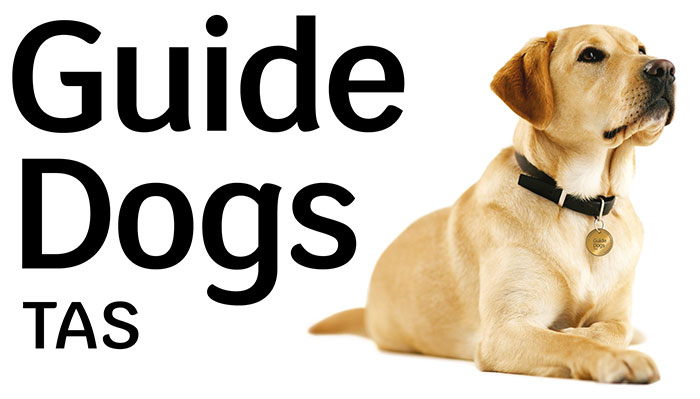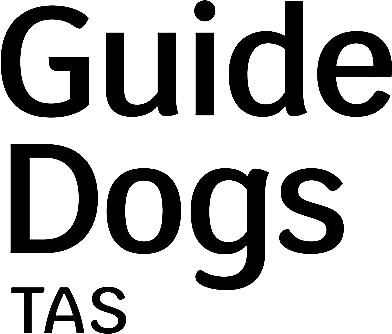What happens to the dogs who don't pass their Guide or Assistance Dog assessment?
Dogs that are not suitable to a career as a Guide Dog or Autism Assistance Dog, are reclassified as Facility or Ambassador Dogs. They will continue to serve a working purpose, bettering the lives of Tasmanians living with disability.
What happens to retired Guide or Assistance Dogs?
This depends on the circumstances of the handler. In many cases, the dog remains with the handler (or a member of their family) and enjoys a well deserved rest after their working life. In the rare case of a handler being unable to adopt their retired Guide or Assistance Dog, Guide Dogs Tasmania rehomes the dog to a suitable, loving family.
How long does it take to train a Guide, Therapy, or Autism Assistance Dog?
It takes nearly two years to train a Guide Dog.
Training starts from very soon after the pups are born. At eight weeks, the pups are placed with volunteer foster families, called Puppy Raisers. Our Puppy Raisers have the pups until they are about 18 months old, during which time they do a lot of work to ensure pups are well socialised and well mannered.
This is followed by four to six months of intensive training with a Guide Dog Instructor ensuring the dog learns all the skills it needs to become a Guide Dog. The dog lives with a Dog Boarder during this time. It then takes a month or so to train each vision impaired person and their Guide Dog so they can work effectively together as a team to ensure their safety and independence.
Where do your dogs come from?
We source puppies from established Guide Dog Breeding centres in Australia and New Zealand. It is important to ensure we have dogs of suitable temperament for Guide Dog work. All training is conducted here in Tasmania by our Guide Dog Mobility Instructors.
How can I tell when a dog is working?
A Guide, Therapy or Autism Assistance Dog is working (or in training) when its wearing its orange training coat or harness.
Is a Guide Dog always working and does it always have to wear a harness?
Guide Dog puppies are conditioned from a very young age to understand that when they are wearing their special puppy coats or their Guide Dog harness, that they are ‘on duty’ and are expected to behave accordingly.
When out of their puppy coat or harness, the dogs are encouraged to play and relax, just like any other dog. Although there are a few special rules to abide by to ensure our dogs are always well mannered when in public. The working role of our Guide Dogs only takes up a minor percentage of their daily routine, therefore play, relaxation and the odd cuddle or two make up a large portion of their daily activities.
How does a Guide Dog know when to cross the road?
Many people believe that the Guide Dog can see the little green man and know it is time to cross. In fact, it is the Guide Dog’s job to get the person safely to the kerb edge. The vision impaired handler has been taught to assess the flow of traffic, using observational skills and their senses (such as hearing).
When the handler believes the road is clear or they have the right of way, they will give the command to cross the road. Guide Dog mobility is all about team work.
What is the average working life of a Guide Dog?
Guide Dogs usually begin work with their clients at about two years of age, with a well-earned retirement at approximately ten years of age.
How does a Guide Dog know where its handler wants to go?
A Guide Dog and its vision impaired handler work together as a team.
The handler is responsible for providing directions to the dog at all times, whilst the dog concentrates on dealing with issues (such as obstacles, kerbs, traffic) that arise in the immediate environment. The handler must be well orientated to their route to ensure they know the number of streets to be crossed, when to turn left or right, and when they have reached their destination.
Meanwhile the Guide Dog will lead them safely and assist locate specific objectives such as doorways and steps. Each Guide Dog will usually remember the route to their handler’s various destinations, once they have been there a few times. However, it is still the handler’s responsibility to consistently be aware of where they are in relation to where they have come from and where they are heading too.
Some Guide Dog handlers have reported that their dog has remembered destinations that they have not travelled to for many months or even years.
How much does it cost to train a Guide, Therapy or Autism Assistance Dog?
Our puppies are specifically bred to meet the demands of Guide Dog work, in order to ensure they are physically and temperamentally suited to the task.
They are then placed with Puppy Raising families to undergo socialisation and initial training in basic good manners. During this time, Guide Dogs Tasmania meets all costs associated with equipment, feeding and supervision for our puppies. In all, it costs in excess of $50,000 to train each of our Guide Dogs.
What is involved in Guide Dog Assessment and Training?
When our puppies are approximately 16 months old, we bring them in for assessment and then, hopefully, the formal component of their training.
We say hopefully, for despite all of our best efforts, both from our staff and our dedicated volunteer Puppy Raisers and Dog Boarders there is no guarantee that our pups will successfully complete the Guide Dog Training Program. Although assessment occurs throughout all phases of the Puppy Raising and Guide Dog Training Programs, it is important that we develop a solid understanding of each pup’s strengths, weaknesses and learning styles immediately upon entering the formal training phase.
We therefore conduct a short, but intensive period of assessment designed to ensure the pup is both mature enough and suitable to enter formal training. Should the pup meet the exacting standards required during assessment, they progress to the formal training component. Once a puppy has successfully completed its assessment, it can then move into formal training with one of our Guide Dog Mobility Instructors. Here they will spend up to six months learning the intricacies of their trade. Each Guide Dog must learn to move smoothly and safely through the environment, taking care to ensure they do not allow their handler to contact obstacles, trip over kerbs or encounter a myriad of other hazards; whilst also ensuring they successfully locate destinations, indicate stairs, escalators and lifts, and successfully locate and negotiate road crossings. It is a big responsibility and our Guide Dogs are thoroughly trained to ensure they are up to the standards as set forth by the International Guide Dog Federation. Once they have successfully completed their training, they are made available for matching with a blind or vision impaired person.
What is Guide Dog Matching?
In order for a Guide Dog to perform at its optimum level, it is important that the Guide Dog and their handler work together as a team. As with any team, if the members work together well, they can achieve things they may have only dreamed about as individuals.
This is very much the case with Guide Dogs. In order for each Guide Dog to reach its potential, we must carefully select where each dog is placed. In order for each Guide Dog Handler to maximise their independent mobility, we must ensure we provide a Guide Dog that complements their lifestyle, their aspirations and their personality. It only takes a second to think of your own lifestyle and how much it differs from say… your grandparent’s, or your grandchildren’s, or your neighbour’s, or even your work colleague’s.
When you consider the different things you do in your life and the things that are important to you, you can readily see why a Guide Dog that is good for you, may not be so suitable for many of the people you know. Some people walk fast and some people walk slow. Some people are tall and some are short. Some lead a leisurely, relaxed life, whilst others are on the go from dawn til dusk and beyond. The dog that is right for me may not necessarily be right for you. Matching each person with the right Guide Dog is a complex art. We spend a lot of time getting to know our dogs and learning as much as we can about the people they work with. This way, we believe we can do our best to provide a dog that complements and supports the individual goals of each person. Once a person has been matched with their Guide Dog, that is when the challenge really begins. Continue onto Guide Dog Client Services stories to learn more about what happens when a blind or vision impaired Tasmanian receives their four legged companion.
Is Guide Dogs Tasmania still involved once a dog is matched with a handler?
Once our Guide Dog has been trained and matched, it is time to start training with their new partner.
Training programs can last for between four and eight weeks for people receiving their first Guide Dog and often substantially less time for people who are returning after the retirement of their previous working Guide Dog. Training is intensive and can cover a broad range of skills, depending on the experience of each person.
Can Guide Dogs go anywhere?
Under The Guide Dogs and Hearing Dogs Act 1967, it is an offence to refuse a person with a Guide Dog entry into a public place.
- A Guide Dog has full public access rights in accordance with the Guide Dogs and Hearing Dogs Act, 1967
- An Autism Assistance Dog has full public access rights in accordance with the Guide Dogs and Hearing Dogs Act, 1967
- Therapy or Companion Dogs do not have public access rights
Sign up to keep up-to-date
Get occasional updates about our puppies and their life-changing journeys, meet the Tasmanians they’re helping, and receive special event invitations.




